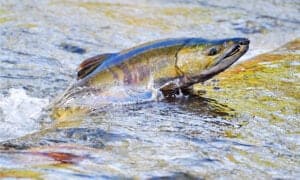The term “salmon” refers to some ray-finned fish species in the family Salmonidae. It is believed that the term salmon was derived from an earlier word that meant “to leap.” It is also thought to be derived from the Latin word salmo. It is important to note that not all members of the Salmonidae family are salmon; others include trout, whitefish, and char. It is worth noting that they are divided into the Atlantic and Pacific salmon.
Only eight species of true salmon are left existing, seven of which are Pacific salmon. There are also four other species of “fake” salmon, including the entirely freshwater Danube salmon, which is more trout-like. Most salmon have developed an anadromous lifestyle, which involves living in saltwater oceans and returning to freshwater sources (often where they were born) to spawn. Although it is also indigenous to the North Atlantic, the North Pacific has the highest concentration. Additionally, the salmon has been introduced into several non-native areas, including Patagonia in South America and the Great Lakes in North America.
Have you always wanted to know more about these fish, particularly their teeth? This article will help you discover new and exciting facts about their teeth, their appearance, and how they use them.
How To Identify Salmon
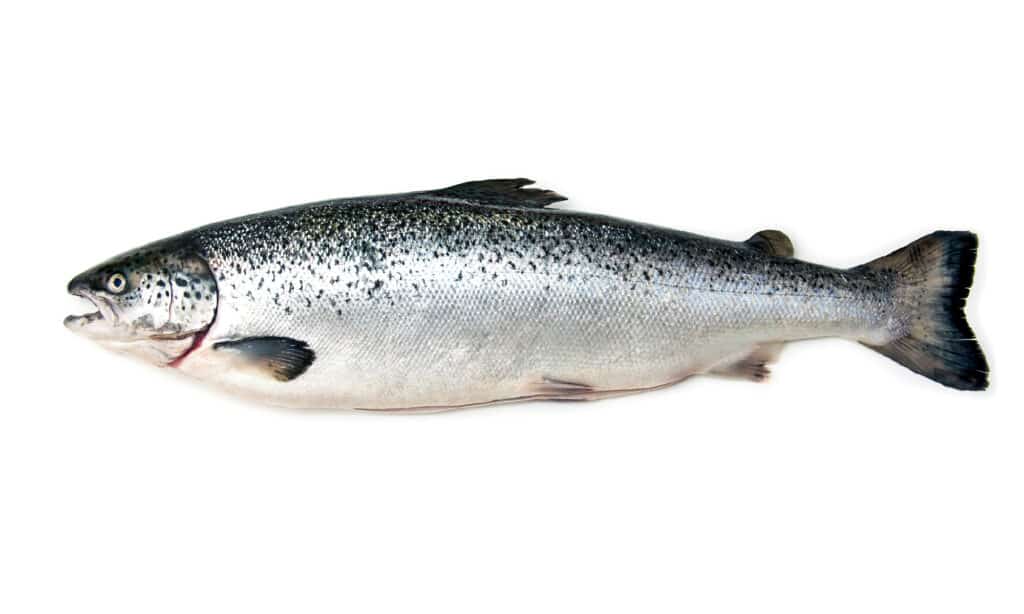
An adult salmon typically weighs between 10 and 20 pounds.
©iStock.com/EddWestmacott
The salmon is a long fish with a pointed or hooked beak, and two pairs of paired fins on the side and pelvis. It has a dazzling silver appearance for most of the year with pockets of blue, red, green, pink, or purple, but when the spawning season approaches, the scales change into various vibrant hues. An adult salmon typically weighs between 10 and 20 pounds, but this range has different variations. The biggest salmon species is the Chinook salmon, appropriately named the king salmon. This species can be found in the Northern Pacific region, from California to Alaska in the east and Japan and Russia in the west.
What Types of Teeth Do Salmon Have?
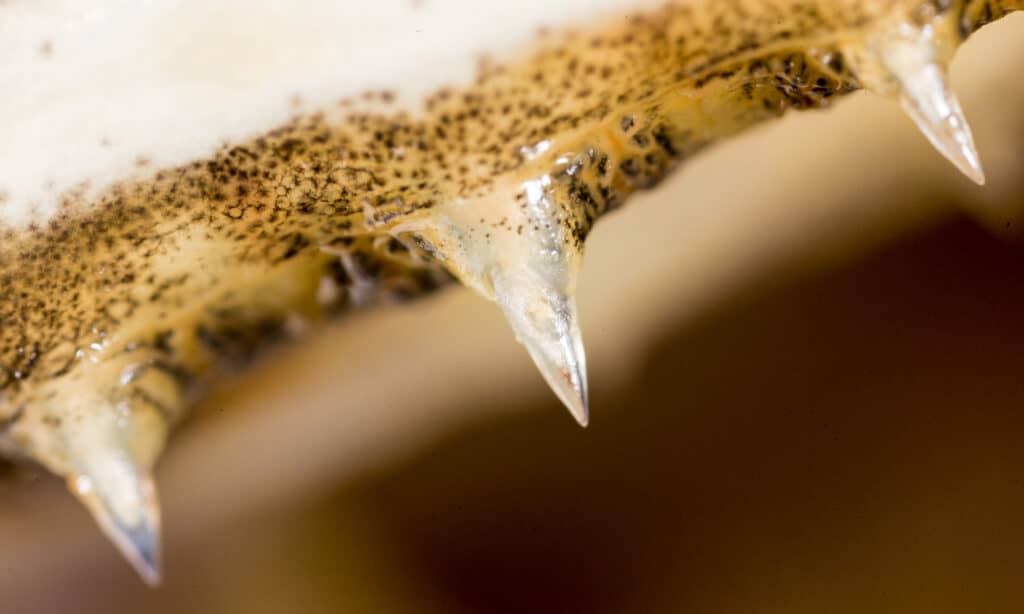
While salmon in freshwater areas develop massive teeth, those in saltwater habitats seem to have relatively small, needle-like teeth.
©schankz/Shutterstock.com
Both groups of salmon- the Atlantic and Pacific salmon have teeth. All salmon species are carnivores that primarily feed on smaller fish species. Like all predators, salmon require teeth to grasp their prey. Because salmon are enormous predatory fish, they have a lot of sharp teeth. While salmon in freshwater areas develop massive teeth, those in saltwater habitats seem to have relatively small, needle-like teeth. The reason for this is that when these fish are in saltwater habitats, their teeth are deeply embedded in their fleshy lips. Yet, when they migrate to freshwater habitats, the change in water causes their bodies to decay slowly, exposing the full size and length of their teeth.
Are Salmon Fish Born With Teeth?
Salmon are semelparous animals, which means they only give birth once in their lifetime before passing away. Many Pacific salmon die within a few days or weeks of spawning. Baby salmon, also called fry, have teeth at the point where they are able to feed themselves. Just like the adults, these young fish are opportunistic feeders and would eat anything they find.
Newly born salmon have teeth that are sufficiently developed to support their predatory behavior, unlike other young fish. In freshwater settings, young salmon typically eat minute insects such as mayflies, stoneflies, caddisflies, blackflies, and riffle beetles. They also occasionally consume small amphibians and fish. Their diet in saltwater is not very different either as they eat more crustaceans like amphipods or krill.
How Many Teeth Do Salmon Have?
Although all salmon species are carnivorous and have teeth to help with their dietary choices, the number of teeth they all have varies. Their mouths have anywhere from 100 sharp teeth depending on the salmon species. Their front teeth are as big as canines, whereas most of the teeth on the side of their jaws are smaller. Despite this disparity, one common thing remains- freshwater makes it seem like all species of salmon have bigger teeth than they do.
Like other animals, fish have evolved to have a variety of teeth depending on their food. For instance, most carnivorous fish have teeth that are made to pierce, grip, and cut their prey, but most herbivorous fish have teeth that are better adapted to shredding things like algae.
Chinook Salmon Teeth
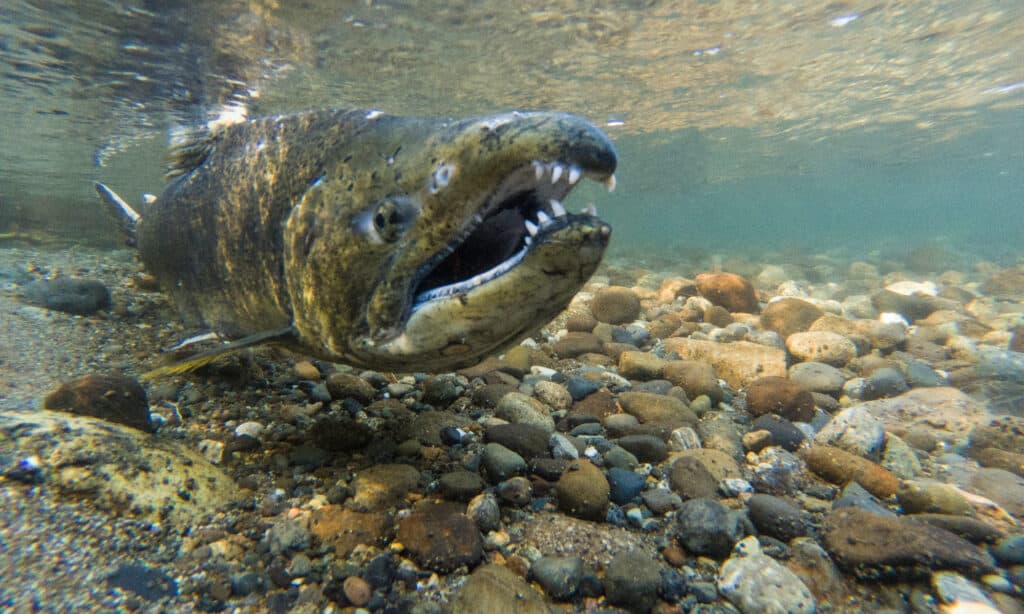
Chinook salmon not only have really large teeth, but they also have several rows of them.
©Kevin Cass/Shutterstock.com
While the rest of the United States refers to them as king salmon, the term “chinook salmon” is just another name for king salmon that is mostly used in Alaska and Canada. These king salmon not only have really large teeth, but they also have several rows of them. These teeth contribute to the king salmon’s strong bite, enabling it to enclose its victim and prevent it from escaping. A king salmon’s mouth is dark, and the gums at the base of its teeth are also black. Fishermen sometimes refer to the king salmon as “black mouth” because of this.
Sockeye Salmon Teeth

Sockeye salmon have sharp teeth resembling canines.
©Sergey Uryadnikov/Shutterstock.com
Sockeye salmon have teeth that are disproportionately larger than their bodies. At first, when they are young, they do not have that many teeth and sometimes even look pretty much toothless. However, when they grow older and become adults, they develop strong, sharp teeth resembling canines.
The sockeye salmon’s tongue is black, while its gums and mouth are white. Also, they have flexible lips akin to chum salmon. Additionally, when the time to spawn draws near, male sockeye salmon start to develop a kype on their top jaw.
Pink Salmon Teeth
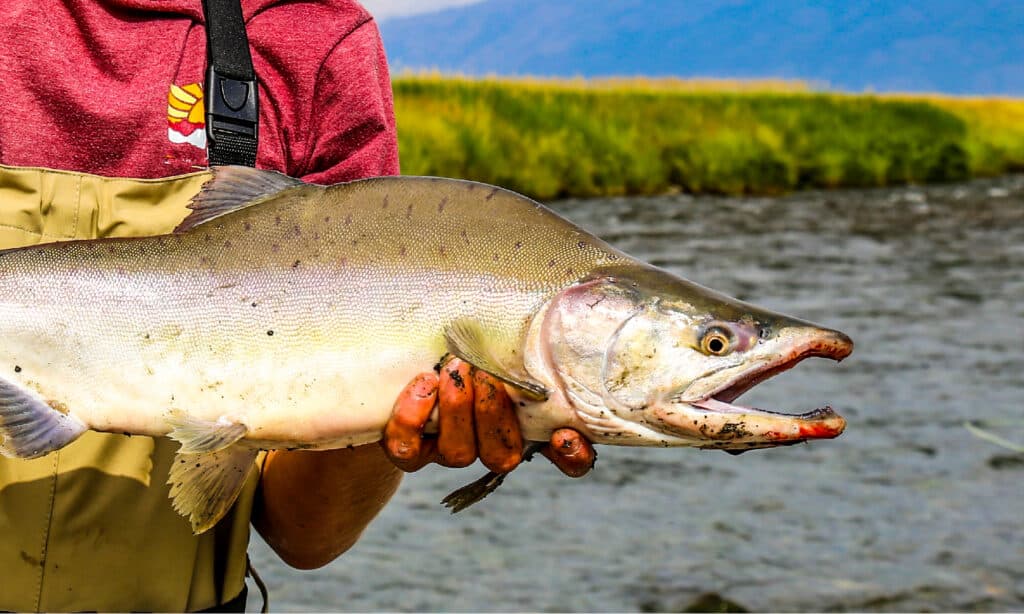
Compared to most other salmon species, the teeth of the pink salmon are spaced a little more apart.
©CSNafzger/Shutterstock.com
The pink salmon’s tongue and gums are black, while its mouth is white. Compared to most other salmon species, the teeth of the pink salmon are spaced a little more apart. Their teeth are pointed inside their mouths and are sharp and somewhat fang-like, so when they bite their prey, it will be more difficult for them to escape. The males also develop a kype, and their lower jaw is more flexible than their upper jaw.
Atlantic Salmon Teeth
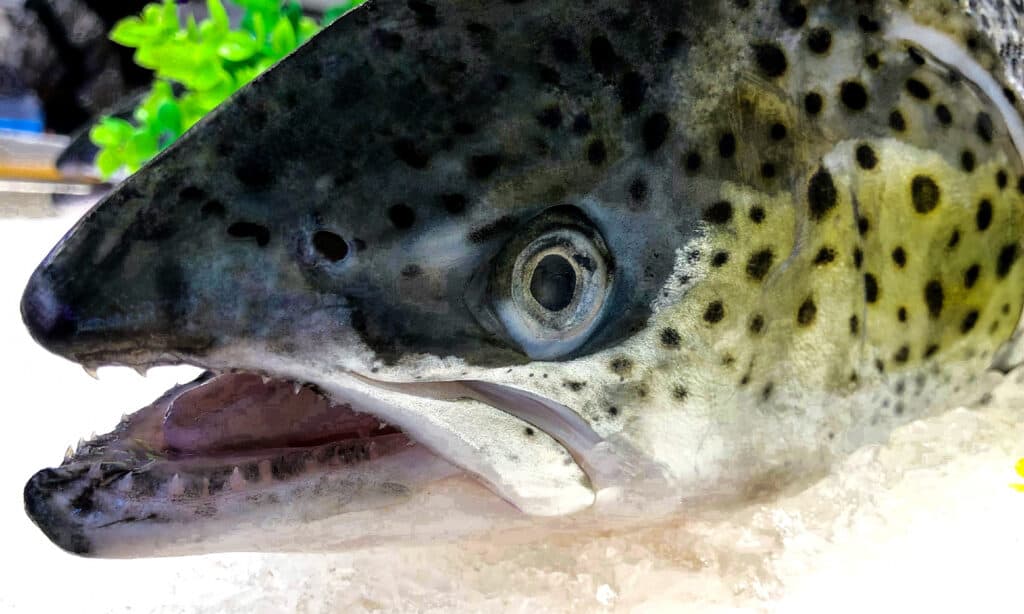
Atlantic salmon teeth don’t protrude like the teeth of other salmon.
©ShamAn77/Shutterstock.com
The teeth of Atlantic salmon are often smaller than those of Pacific salmon, and they also are not as obvious as the others. Atlantic salmon teeth don’t protrude like the teeth of other salmon. This is because they don’t expend all their energy swimming upstream, preventing total body decay and jaw degeneration that exposes their teeth.
Up Next:
What Do Salmon Eat? 12 Foods in Their Diet
Discover the 7 Largest Salmon on Earth
The photo featured at the top of this post is © takas0325/Shutterstock.com
Sources
- NOAA Fisheries, Available here: https://www.fisheries.noaa.gov/national/outreach-and-education/fun-facts-about-amazing-atlantic-salmon
- , Available here: https://deneki.com/2016/08/watch-your-fingers/
- Good Time Dave's Fishing, Available here: https://www.gtdfishing.com/charters/what-we-catch/salmon/
Thank you for reading! Have some feedback for us? Contact the AZ Animals editorial team.




